Cet article est également disponible en: French
Bears filmed recently in the commune of Melles where the first Slovenian bears were released in 1996
Although there are many aspects to the debate, one of the main issues separating the pro- and anti-bear camps is the importance to be given to the number of sheep killed by bears. Is it a significant figure or not?
The official figures for bear attacks
| Bear attacks in France | 2006 | 2010 | 2015 |
| Animals (mainly sheep) killed by bears | 221 | 167 | 145 |
| Estimated minimum number of bears | 15 | 19 | 29 |
The official figures do not take into account losses due to miscarriages, sheep which simply disappear, and sheep which have been plucked clean by vultures so that the cause of death cannot be determined. When only a couple of sheep are lost the work involved in declaring the death may not be considered worth the compensation. These sheep won’t appear in the statistics either.
Let’s be pessimistic and say that there could be 300 deaths attributable to bears per year. In comparison with the 10,000–20,000 deaths in the estives (summer pastures) each year (out of 570,000 sheep) this might seem a small figure. But if you live in the High Ariège where bears have repeatedly attacked, you won’t have the same perspective.
A little history
After centuries of decline, by 1996 the French brown bear population was destined for extinction, surviving only in the Pyrenees. The authorities released a total of three bears from Slovenia in that year and 1997. In 2006 a further five bears arrived in the face of massive and sometimes violent protests from farmers. From 2006 to 2012, the Pyrenees and Ariège in particular were the scene of many demonstrations against the new arrivals.
At the end of the day, the Pyrenean sub-species has not been saved from extinction: all the bears have Slovenian DNA in their blood.
The case against the bears
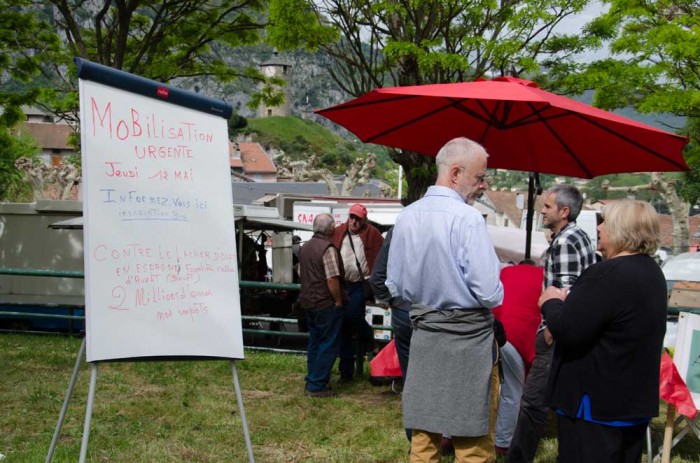
The ASPAP stand at the Tarascon Sheep Fair. The sign reads: urgent mobilisation Thursday 12 May. Information here. Sign up for the bus. Against the release of a bear in Spain (across the frontier from the Auzat valley, Bouet). Two million euros from our taxes.
As James Rebanks so eloquently wrote in his book The Shepherds Life people who live and work in the hills don’t see them in the same way as tourists. When he was young he didn’t think the hills were beautiful: they were just there. Only later did he fully realise his family’s part in sculpting the landscape which outsiders found so enchanting. So I always make a special effort to talk to locals, in this case to Martine Perez and Monique Mathe.
Earlier this year I was at the 759th Tarascon sheep fair. Martine and Monique were handing out leaflets for a forthcoming event: Les Rencontres Ariégeoises de l’Écologie Pastorale (Ariège Colloquium on the Ecology of Pastoral Farming) which was scheduled for 1 July but has now been postponed to September. The event will be organised by the anti-bear ASPAP.*
Martine and Monique are angry, and when they tell me their experiences at the claws of the bears it is clear why.
Monique: We used to raise sheep in the commune of Orgeix [near Ax-les-Thermes]. We were the first to be hit, and so we quit. Now we have cows. There were six breeders sharing the mountain pastures. The others went elsewhere. We split up because we couldn’t stand it anymore. We lost ten percent! We resigned all together; we wanted to make an impact. There was one who didn’t want to quit but all the rest of us resigned.
Steve: How many sheep did you lose?
Monique: We lost 17, in just one year out of a herd of 100. It’s huge! That makes 10% gone [on average]. We engaged a solicitor to put our case to the government. That was before the ASPAP existed. We lost of course. Afterwards when other breeders were hit, that was when we started to get together and it was then we created the ASPAP… Nobody told us anything [about the bears]. It just happened, nobody knew anything beforehand.
Steve: You’re talking about…
Monique: …the mid-90s.
Steve: Yes. The first reintroductions.
Monique: We knew nothing! The local population never knew anything. Did the politicians know? I have no idea. And then perhaps they thought that it wasn’t going to be like that, I don’t know. I don’t want to throw stones.
Twenty years later it still hurts.
***
Martine: I have horses. We take them up to the mountain at Orlu and we have lost – the bear has killed – sixteen mares.
Steve: Sixteen mares in how long?
Martine: Eleven years.
Martine: Sometimes it is a real tragedy. Farmers are abandoning their profession because they can’t work correctly. They can’t find shepherds any more. The shepherds don’t want to go up to the mountains any more. They work night and day. Because they have to be there, present. And in the day they have to go to count the dead animals, spending hours and hours searching for the animals. Often it is the birds of prey, eagles, vultures – griffon vultures to be precise – which indicate a dead beast.
Steve: And how do you get on with the Orlu National Nature Reserve?
Martine: Very well. There is a good director. We are good friends and well…
Steve: But don’t you have different points of view on the bears?
Martine: We don’t talk about it. He knows our point of view and we are supposed to know his. We don’t talk about it. So we stay on good terms, you see.
So what does the director say? According to the 2013-2017 Management Plan: “the reintroductions were a success from a biological point of view… However these reintroductions have engendered strong resistance from livestock breeders and local politicians… The individual [bear] present in the Orlu area moved to the central Pyrenees in Spring 2011.” The preservation of historic species is an objective and bears (along with wolves) are to be given top priority.
***
The ASPAP website says that the “measures of protection [recommended by the authorities include] guard dogs, electric fences for the sheepfolds where sheep should be corralled at night, and hiring more shepherds. In reality experience has shown that, although in some cases this reduces the attacks, in most cases these measures do not work. On high mountains (2000–2800m) or on steep slopes it is impossible to envisage corralling the sheep every night. This corralling would result in weaker animals (long daily walks stopping the sheep eating in the cool of the morning and evening, trampling and increasing sickness…) and vulnerability in case of attack.”
“8 July 2007. The bear was here, despite the three guard dogs. He killed one sheep but 93 others, terrorised by his presence, threw themselves down the steep slope.”
“Result: 94 animals dead. Before the arrival of the bear a herd of 1200 sheep, owned by 2–3 breeders, lost less than five animals in the summer pastures. And that is despite the difficult terrain… They said to this breeder: a hut, a shepherd, a sheepfold, dogs… He did everything to protect himself. Ecological extremists who know nothing of the mountains insist that we attack the Pyrenees with thousands of kilometres of electric fences.”
***
The protesters have been less visible in the media since 2012. The 12 May demonstration the ASPAP was advertising in Toulouse was small, only attracting about 30 protesters. But on 1 July 150-250 protesters again demonstrated outside the préfecture hoping to influence the Comité du Massif, a consultative body debating the future of the bears that day.
La réintroduction de l’Ours en suspens
The Committee was evenly split: fifteen votes for more reintroductions; fifteen against. The Annual General Meeting of the ASPAP, initially scheduled for 1 July, then reprogrammed for 2 September has been postponed again to “the end of 2016”.
***
I would like to thank Martine and Monique for taking the time to give me their views.
*ASPAP : Association de Sauvegarde du Patrimoine d’Ariège-Pyrénées (Association for the Conservation of the Heritage of the Ariège Pyrenees)
The case for the bears
Meanwhile the pro-bear groups FERUS – Pays de l’Ours – ADET are celebrating the 20th anniversary of the first reintroductions. [Press release in French]
FERUS claims that the return of the bears has permitted the modernisation of sheep farming in the Pyrenees as a result of programmes, initially linked with their arrival, which finance shepherds, renovation of huts, protective measures, transport and communications.
“The significant gains from these measures (healthier herds, better pasture management and global reduction in mortality) are very much greater than the impact of the bears”
Previously mortality in the summer pastures was 3–5% of the herd according to one of the sheep farmers who gave evidence before the Parliamentary commission on pastoralism in 2003
- Francis Ader [sheep farmer, now vice-secretary of the Haute-Garonne Chamber of Agriculture]: We are a dozen breeders and we employ two shepherds.
- Augustin Bonrepaux: So it is an agricultural cooperative. How many animals in total?
- Francis Ader: 2500. As we have a very extensive mountain, we are obliged to employ two shepherds to make two units of 1200 sheep.
- Augustin Bonrepaux: Two units of 1200 sheep. That’s a lot.
- Francis Ader: It’s the maximum to be able to arrive at, for this type of territory, to end up with about 3–5% losses.
- Augustin Bonrepaux: If you wanted to bring the herd back every evening, according to what the last minister told me one day, you would need at least four shepherds. And even then it wouldn’t be easy.
- André Chassaigne: What is the cause of these 3–5% losses?
- Francis Ader: 80% are accidental falls.
- Joël Giraud: You lose fifty animals per unit.
- Francis Ader: That’s the minimum
I have not been able to find any recent estimates of losses for flocks with shepherds and guard dogs (apart from the exceptional instance mentioned above).
***
Dramatic attacks by bears attract media attention; day-to-day losses don’t. Nevertheless for the individual farmer with a carcass at his or her feet, for the Couserans area, the bear-related deaths are significant. At a global level losses may seem less important, for the moment. But the current bear population isn’t viable in the long term.
How many bears would be needed then? Nobody seems to really know, but in Spanish Cantabria the numbers have risen to 240. The Fundación Oso Pardo which looks after them still thinks that “The main conservation problem is the shortage of numbers… the two sub-populations are very small.” Source: Fundación Oso Pardo.
What then is the future for sheep farming in the Pyrenees? ASPAP and others say that some estives cannot be adapted. Judging by past experience these pastures will be abandoned and over the next generation trees will encroach, changing the landscape considerably. Some areas will become much less accessible.
Is it worthwhile? Should the process be stopped or reversed? That is a big question.


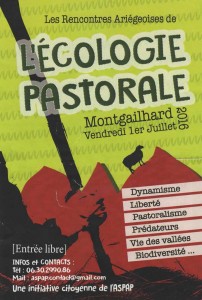
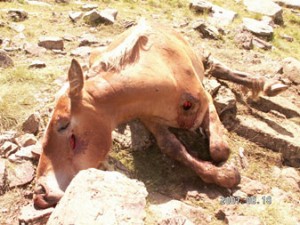
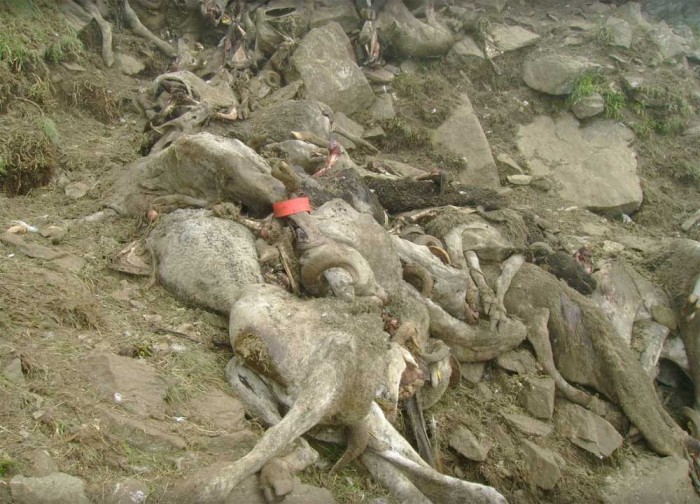

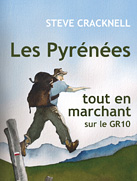
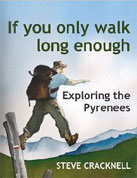

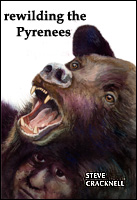



Footprints on the mountains